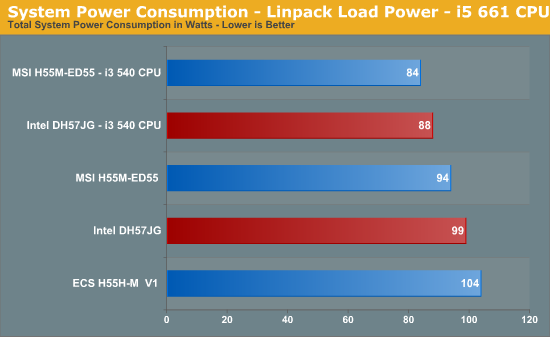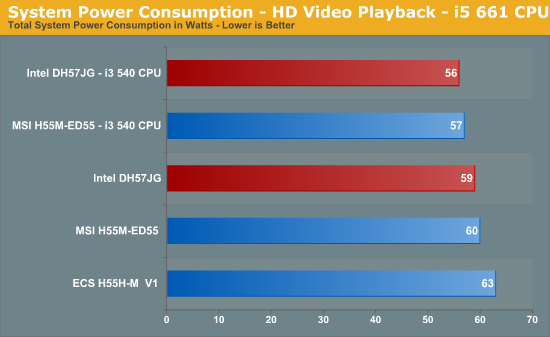Intel DH57JG “Jet Geyser” - Intel's First Mini-ITX H57
by Rajinder Gill on March 1, 2010 2:00 PM EST- Posted in
- Motherboards
Test setup and power
| Testbed Setup | |
| Processor |
Intel Core i5 661 ES CPU - 3.33GHz - 2 Cores 4 Threads, 4MB L3 Cache
Intel Core i3 540 CPU - 3.06GHz - 2 Cores, 4 Threads, 4MB L3 Cache |
| CPU Voltage |
Various
|
| Cooling |
Intel Air Cooler, Heatkiller 3.0 Waterblock, PA120.2 radiator and DDC ultra pump (with Petra top). 1/2 ID tubing for watercooling
|
| Power Supply |
Corsair HX950
|
| Memory |
Corsair Dominator CMD8GX3M4A1600C8 1600MHz Rev 3.1
|
| Corsair Dominator CMD8GX3M4A1600C8 1600MHz Rev 7.1 | |
| Corsair XMS3 CMX8GX3M4A1333C9 1333MHz Rev 2.3 | |
| G.Skill Perfect Storm 8-8-8-24 2200MHz 4GB kit | |
| Corsair Dominator GT 8-8-8-24 2200MHz 4GB kit Rev 2.1 | |
| Video Cards |
MSI GeForce GTX 275 Lightning (Stock Clocks)
|
| Video Drivers |
NVIDIA 195.62 WHQL
|
| Hard Drive |
Western Digital 7200RPM 1TB SATA 3Gbps 32MB Buffer
OCZ Vertex 120GB SSD |
| Optical Drives |
Pioneer DVR-215DBK
|
| Case |
Open Test Bed - Dimastech Benching Station, Lian-Li V2110
|
| Operating System |
Windows 7 64-bit
|
We utilized memory kits from Corsair and G.Skill to verify memory compatibility on our test boards. Our OS and primary applications are loaded on the OCZ Vertex 120GB SSD drive and our games operate off the WD Caviar Black 1TB drive. We did a clean install of the OS and applications for each motherboard. We used Intel's stock cooler for the stock comparison testing, while water-cooling via the superlative Heat Killer 3.0 water block was utilized for overclocking. For graphics duty, MSI’s GTX 275 Lighting GPU was used to provide performance comparisons between boards during gaming benchmarks.
For our test results we set up each board as closely as possible in regards to memory timings. Otherwise all other settings are left on auto. The P55 utilized 8GB of memory where possible, while the X58 platform contained 6GB. The P55 and X58 DDR3 timings were set to 7-7-7-20 1T at DDR3-1600 for the i7-920 and i7-870 processors at both stock and overclocked CPU settings.
We used DDR3-1333 6-6-6-18 1T timings for the i5-750 stock setup for all system benchmarks (non-gaming tests) as DDR3-1600 is not natively supported at a stock BCLK setting of 133. For our Clarkdale i5 661 and i3 540 CPU’s, we used 7-7-7-20 1N timings at DDR3-1333MHz with 8GB of memory. We would have preferred to use CAS 6 timings to match our Lynnfield setup, but it seems 8GB of memory at CAS 6 on Clarkdale is not possible right now. The 4GHz gaming results used 8GB of memory at DDR3-1280MHz with CAS 6-6-6-18 1N timings to allow a BCLK of 200MHz.
The obvious compare would be to Zotac's H55-ITX, however, we've recently added new members to our reviews team and are still working towards getting everybody working with a common set of components for comparison purposes. Please bear with us while we sort things out.
Power Consumption
Our power consumption testing utilizes the same batch of components under similar circumstances in a bid to monitor variances between idle and CPU load conditions using an AC wall meter for power consumption measurements. We install the vendor supplied power saving utilities on each board and enable power saving modes that don't involve any kind of underclocking or CPU core frequency modulation in order to run an apples to apples comparison. Assuming a maximum 105w load in the worst case scenario, actual motherboard power consumption is around 20% lower than the shown figures if you factor out switching losses at the PSU.



We threw Intel’s DH57JG in against the highly efficient MSI H55M-ED55; the mini-ITX comes out on top during light/medium loads, faltering to MSI only when the CPU is fully loaded. Either way, the DH57JG's power draw figures are highly impressive. Please excuse our use of the Corsair TX950 for these tests; this PSU was used in order to provide a straight compare to other boards in our database.










34 Comments
View All Comments
Forgetsalvation - Thursday, March 25, 2010 - link
I talked to Intel presales support, i was informed that essentially this motherboard's BIOS has been locked down so that it will not support the core i7.unfortunately i did not discover this until after i purchased this motherboard and a i7-860.
I was very hopeful when I saw this review showed a i7-860 that worked, how ever i still can not get my system to boot.
Do the moderators have any suggestions for me, i very much want to run this combo but I am running out to time to return these parts if they will not work
Erick Thompson - Monday, March 22, 2010 - link
I would love to use the M350 case from mini-box, but the largest power supply I can get is 102 watts. With this board and a i3 530 (using integrated graphics), along with a SSD drive, it seems like 102 watts would be enough, if pushing the edge a bit. Any thoughts?fbd - Tuesday, March 16, 2010 - link
Yeah im interested in that also... I see that actually u tested a Core i7 in the board but i read in the documentation of the board that it is designed to support cpus up to 87W TDP only, while the i7 has 95 W. What does that mean? Is some kind of hardware part ( e.g. circuitry) of the board not sufficient to support an i7 or what? Or does it support it only at lower speeds? Im a bit confused. What does this mean: "We managed to get the board to post at 21X150 BCLK, but found processor core frequency throttles down to 3GHz or so under full load to ensure safety for the CPU VRM". Does it mean that if u put a stock core i7-860 into the board it wont be able to operate over 3ghz? What about turbo boost then? It cant go over 3ghz either? Thx for any reply.abnderby - Saturday, March 6, 2010 - link
Inoticed your comment about not reviewing many intel boards. Yes I do agree with you on the fact that they do not offer the best package of thrills and frils. But it has been my experience with many of the other manufacturers that the quality and length of service of their boards are no where near that of Intels. I have run into many issues with other boards after a year of 24/7 use. Some of the board components would fail or the boards would die.Over the last 12 years I have only had 2 Intel boards die with less than 5 years of service. None of which were my workstation/server boards or high end PC boards. Intel does put in a tremendous amount of quality that lasts.
Currently I run 1 dual xeon that is 6 years old with 2 3.6 GHz xeons with 64 bit Windows 7. It stills runs flawlessly. I run a core 2 on intel uBTX 3 years now flawlessly.
So please your crowd out here is not just enthusiests that like or have to overclock everything. Many of us want the high quality and long lasting systems. Intel boards must be in that mix.
Duane
MamiyaOtaru - Friday, March 5, 2010 - link
Jet Geyser is one of my favorite thermal features in Yellowstone. Around the corner from the Fountain Paint Pots. It's not a very big one though. Wonder if Intel had it in mind when naming their boardmschira - Monday, March 1, 2010 - link
HiI love these powerful low power systems!
I would be very interested in tests of a file server based on these board.
Like using a Highpoint RocketRAID 2322 system.
Cheers
M.
AmdInside - Monday, March 1, 2010 - link
The P45 based mini-itx board from Intel had a lot of issues. I am not sure if I would jump on this one myself.hnzw rui - Tuesday, March 2, 2010 - link
As far as I'm aware, Intel doesn't have a P45 Mini-ITX board. They do have an Intel DG45FC which is a G45 board.play2learn - Monday, March 1, 2010 - link
Usb 3.0 and 32 nm graphics...Then maybe!blyndy - Monday, March 1, 2010 - link
It looks like m-itx is the new m-atx, which is great.